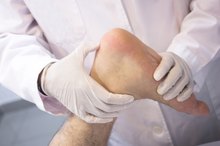Causes of Fever & Back Pain
The combination of fever and back pain can be worrisome for a patient, since it is one of the patterns doctors look for when ruling out dangerous disorders such as cancer or infection. Fortunately, the most common cause of fever and back pain together is simply a coincidental occurrence of their most common individual causes, neither of which is a serious medical problem.
Common Causes
The most common cause of back pain is musculoskeletal, that is, a strain or sprain of the muscles, tendons and ligaments brought on by excessive or unusual exertion. The most common cause of a fever is a viral upper respiratory infection such as a cold or flu. It's not surprising, then, that the most common cause of fever and back pain is simply when both of these things happen to occur at the same time. In addition, one of the symptoms of the flu is heightened perception of muscle and joint pain, so it can cause greater awareness of back pain that was previously ignored. Musculoskeletal back pain rarely leads to long-term problems, and is best treated by rest, hot compresses and aspirin or ibuprofen. Colds and flu are equally routine, and are best treated by rest and increased fluid intake.
- The most common cause of back pain is musculoskeletal, that is, a strain or sprain of the muscles, tendons and ligaments brought on by excessive or unusual exertion.
- In addition, one of the symptoms of the flu is heightened perception of muscle and joint pain, so it can cause greater awareness of back pain that was previously ignored.
Cancer
What Are the Signs & Symptoms of Bladder & Kidney Cancer?
Learn More
While cancer that originates in the spine itself is extremely rare, it is common for cancers that begin in other organs to spread, or metastasize, to the spine. Cancers that frequently lead to spinal metastasis include breast, lung, prostate, thyroid, kidney and lymphomas. While these cancers are usually detected before they metastasize to the spine, occasionally back pain from metastasis is the first symptom that prompts a patient to seek medical attention. In a paper published in the May 1988 "Journal of General Internal Medicine," 0.66 percent of 1,975 patients seeing a doctor primarily for back pain were found to have underlying cancer. Cancer of any sort is usually accompanied by constitutional symptoms such as fever, unintentional weight loss and fatigue. Doctors screen for these symptoms when evaluating a patient with back pain, just to be sure that a previously undetected cancer is not the cause. They also look for signs of damage to spinal nerves, such as numbness in the inner thighs and genital region, since such damage is more likely to result from a tumor metastasis then from other causes of back pain.
- While cancer that originates in the spine itself is extremely rare, it is common for cancers that begin in other organs to spread, or metastasize, to the spine.
- They also look for signs of damage to spinal nerves, such as numbness in the inner thighs and genital region, since such damage is more likely to result from a tumor metastasis then from other causes of back pain.
Infections
Bacterial infections are another more dangerous, although less common, cause of back pain. Again, infections that arise in the spine itself are uncommon, but in some cases infections starting at other sites can spread there. In addition, infections in other abdominal and pelvic organs, such as the kidney or bladder, can cause pain that radiates to the lower back. Since bacterial infections are often accompanied by fever, doctors will look for potential sources of infection when evaluating a patient with fever and back pain. They will look for other symptoms, such as painful urination or blood in the urine, and may order a white blood cell count if such symptoms are present.
- Bacterial infections are another more dangerous, although less common, cause of back pain.
- They will look for other symptoms, such as painful urination or blood in the urine, and may order a white blood cell count if such symptoms are present.
Related Articles
References
- "Harrison’s Principles of Internal Medicine"; Dennis L. Kasper; 2005
- "Journal of General Internal Medicine"; Cancer as a Cause of Back Pain; Richard A. Deyo; May 1988
- Scherl SA. Adolescent idiopathic scoliosis: Clinical features, evaluation, and diagnosis. UpToDate. Updated November 22, 2019.
- National Institute of Neurological Disorders and Stroke. Low Back Pain Fact Sheet. Updated August 13, 2019.
- American Academy of Orthopedic Surgeons. Low Back Pain.
- Biyani A, Andersson GB. Low back pain: pathophysiology and management. J Am Acad Orthop Surg. 2004;12(2):106-115.
- Goel A. Is it necessary to resect osteophytes in degenerative spondylotic myelopathy? J Craniovertebr Junction Spine. 2013;4(1):1-2. doi:10.4103/0974-8237.121615
- National Institute of Arthritis and Musculoskeletal and Skin Diseases. Spinal Stenosis. Updated August 2016.
- American Academy of Orthopaedic Surgeons. Spondylolysis and Spondylolisthesis. 2016.
- Scherl SA. Adolescent idiopathic scoliosis: Clinical features, evaluation, and diagnosis. Updated November 22, 2019.
- Casazza BA. Diagnosis and Treatment of Acute Low Back Pain. Am Fam Physician. 2012;85(4):343-350.
- National Center for Complementary and Integrative Health. Mind and Body Approaches for Chronic Pain: What the Science Says. 2019.
Resources
Writer Bio
Sydney Hornby specializes in metabolic disease and reproductive endocrinology. He is a graduate of Claremont McKenna College and Drexel University College of Medicine in Philadelphia, where he earned his M.D., and has worked for several years in academic medical research. Writing for publication since 1995, Hornby has had articles featured in "Medical Care," "Preventive Medicine" and "Medical Decision Making."





